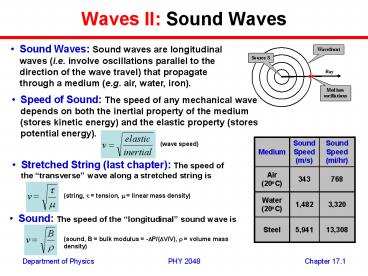Waves II: Sound Waves - PowerPoint PPT Presentation
1 / 8
Title:
Waves II: Sound Waves
Description:
... of Sound: The speed of any mechanical wave depends on both the inertial property ... The intensity, I, of a sound wave at a surface is the average energy per unit ... – PowerPoint PPT presentation
Number of Views:173
Avg rating:3.0/5.0
Title: Waves II: Sound Waves
1
Waves II Sound Waves
- Sound Waves Sound waves are longitudinal waves
(i.e. involve oscillations parallel to the
direction of the wave travel) that propagate
through a medium (e.g. air, water, iron).
- Speed of Sound The speed of any mechanical wave
depends on both the inertial property of the
medium (stores kinetic energy) and the elastic
property (stores potential energy).
(wave speed)
- Stretched String (last chapter) The speed of the
transverse wave along a stretched string is
(string, t tension, m linear mass density)
- Sound The speed of the longitudinal sound wave
is
(sound, B bulk modulus -DP/(DV/V), r volume
mass density)
2
Waves II Sound Waves
- Traveling Sound Waves in Air A traveling sound
waves consist of a moving periodic pattern of
expansions and compressions of the air. As the
wave passes the air elements oscillate
longitudinally in simple harmonic motion.
(1000 Hz sound wave with DPmax at the threshold
of pain!)
Longitudinal displacement
Pressure variation
(The pressure amplitude is related to the
displacement amplitude!)
3
Sound Waves Intensity and Level
- Intensity Traveling sound waves transport energy
(kinetic and potential) from one point to
another. The intensity, I, of a sound wave at a
surface is the average energy per unit time per
unit area transmitted by the wave to the surface
(i.e. average power per unit area). It is also
equal to the average energy per unit volume in
the wave times the speed of propagation of the
wave.
(the intensity is proportional to the square of
the amplitude!)
Watts/m2
- Variation with Distance If sound is emitted
isotropically (i.e. equal intensity in all
directions) from a point source with power Ps and
if the mechanical energy of the wave is conserved
then
(intensity from isotropic point source)
- The Decibel Scale Instead of speaking about the
intensity I of sound, it is more convenient to
speak of the sound level b, where
(sound level, dB decibel, I0 10-12 W/m2)
4
Sound Waves Examples
- The maximum pressure amplitude DPmax that the
human ear can tolerate in loud sounds is about 28
Pa (which is much less that atmospheric pressure
of about 105 Pa). What is the displacement
amplitude smax and the intensity I (in dB) for
such a sound in air of density 1.21 kg/m3, at a
frequency of 1,000 Hz, and a speed of 343 m/s?
- The pressure amplitude DPmax for the faintest
detectable sound at 1,000 Hz is 2.810-5 Pa.
What is the displacement amplitude smax and the
intensity I (in dB) for such a sound in air of
density 1.21 kg/m3 and a speed of 343 m/s?
5
Sound Waves Doppler Effect
(Source and detector at rest)
- Doppler Shift If either the detector or the
source of sound is moving, or if both are moving,
then the emitted frequency, fs, of the source and
the detected frequency, fobs, are different. If
both the source and the detector are at rest with
respect to the air and v lsfs is the speed of
sound in air then
(source stationary, detector stationary)
- Detector Moving, Source Stationary If source is
at rest and the detector is moving toward the
source with speed vD with respect to the air and
v lsfs is the speed of sound in air then
(Source at rest, Detector moving toward the
source)
(source stationary, detector moving toward the
source)
(source stationary, detector moving toward () or
away (-) from the source)
6
Sound Waves Doppler Effect
(detector stationary, source moving toward the
detector)
- Detector Stationary, Source Moving If detector
is at rest and the source is moving toward the
detector with speed vs with respect to the air
and v lsfs is the speed of sound in air and Ts
1/fs is the time between emitted pulses then
(detector stationary, source moving toward the
detector)
(detector stationary, source moving toward (-) or
away () from the source)
- Detector and Source Moving If detector is moving
with speed vD and the source is moving with speed
vs with respect to the air then there are the
following four possibilities
Detector
Detector
Detector
Detector
7
Sound Waves Examples
- A low flying airplane skims the ground at a speed
of 200 m/s as it approaches a stationary
observer. A loud horn whose fundamental
frequency is 400 Hz is carried on the plane.
What frequency does the ground observer hear?
(Assume that the speed of sound in the air is 340
m/s.)
- If instead the horn were on the ground, what
frequency would the airplane pilot hear as she
approached?
8
Sound Waves Shock Waves
- Source Moving at the Speed of Sound If a source
is moving at a stationary detector at speed vs
v then
(source moving at speed vs v)
(source keeping up with its own spherical
wavefronts!)
- Supersonic Speeds If the source moves faster
than sound (i.e. vs gt v) then the Doppler Shift
formula no longer apply. The favefronts extend
in three dimensions and bunch up along a cone
called the Mach cone and a shock wave is said
to exist along the surface of the cone, because
the bunching causes an abrupt rise and and fall
of the air pressure as the cone passes through
any point. The burst of sound caused by the
Mach cone is called a sonic boom.
(source moving at speed vs gt v)
(Mach cone angle, vs/v Mach number)































